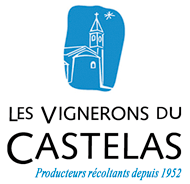Designation of origin controlled CÔTES DU RHÔNE
Geography of the Côtes du Rhône appellation
Côtes-du-Rhône is a wine of Designation of origin controlled on the right and left banks of the Rhône river. It is a regional appellation and its production area is very large.
It was from Vienne in the north, to Nîmes in the south over a distance of about 250 kilometers for an east-west width of about 70 kilometers on either side of the Rhône.
The appellation is one of the most extensive and diversified in France, as it encompasses six departments: Loire, Rhône, Ardèche, Drôme, Vaucluse, and Gard (the latter three covering most of the surfaces), and 250 municipalities.
Côtes du Rhône: the terroir
In the beginning, 300 million years ago, the tumult between the Massif Central and the Alps formed a collapsing pit filled in by the Mediterranean Sea.
The volcanic activity of the Massif Central and the marine and fluvial deposits along this pit gradually form the reliefs that we know today as the Dentelles de Montmirail or the giant of Provence, the Mont Ventoux.
Gradually with the withdrawal of the Mediterranean Sea, the terroir we work on today is taking hold.
It is formed mainly from four types of rocks: Granite, Sandy Silica, Limestone and Clay.
This diversity of soils plays an essential role for the vines, and allows a wide disparity of wines from the Côtes du Rhône.
The history of the appellation
In the 1st century AD, vines developed in the Rhône valley and competed with Italian vineyards. The Romans greatly developed the work of the vine, giving a great impetus to the formation of commercial vineyards like that of Donzère formerly called Villa du Molard or those around Vienne which are the subject of great renown.
The collapse of the Roman Empire marks a severe blow for the wines of the Rhône valley, only those close to the ports of the Mediterranean and the Northern Rhône survive by supplying Lyon and its region. It was the influence of the Church in the Middle Ages that allowed viticulture to restart. Under the influence of the Popes recently settled in Avignon in the Comtat Venaissin.
The Avignon vineyards are given new impetus by the consolidation of the port of Roquemaure (Gard) as a major river expedition center. The "Côste du Rhône" at the end of the 17th century then became the name of an administrative district of the Viguerie d'Uzès (Gard), which was very famous at the time.
In 1650, to guarantee their origin and their quality, the wines were subject to regulations, but it was not until the 19th century that the Côste du Rhône became the Côtes du Rhône by extending to the vineyards located on the left bank. of the Rhône.
In 1930, the visionary Baron Le Roy, a winegrower in Châteauneuf-du-Pape, recognized the characteristics of the wines of the Rhône valley and obtained the denomination of the Appellation d'Origine Contrôlée validated in 1933.
In 1936, the notoriety acquired over the centuries was validated by the Courts of Grande Instance of Tournon and Uzès.
AOP Côtes du Rhône wines are available in white, rosé and red.

L'Amarante
L'Amarante


Roca Fortis Rouge
Roca Fortis Rouge


Cuvée d'Antan
Cuvée d'Antan


Les Mésanges
Les Mésanges


Liscardinal
Liscardinal


Domaine du Grand Belly
Domaine du Grand Belly


Roca Fortis Blanc
Roca Fortis Blanc


Le Monarque Rouge Bio
Le Monarque Rouge Bio


Le Monarque blanc Bio
Le Monarque blanc Bio


Le Monarque rosé Bio
Le Monarque rosé Bio






